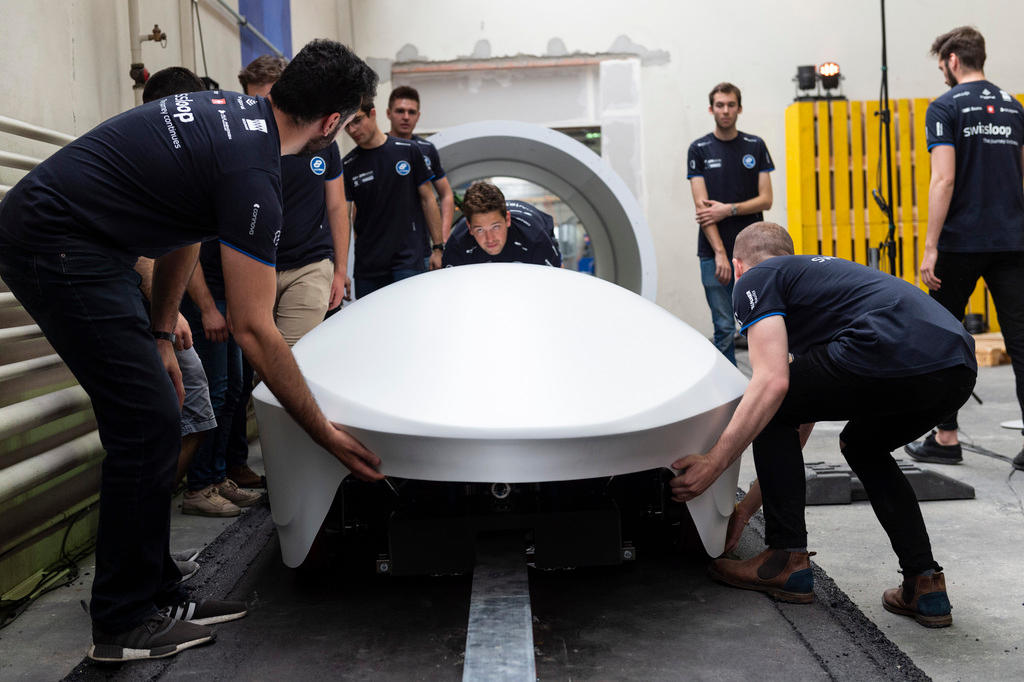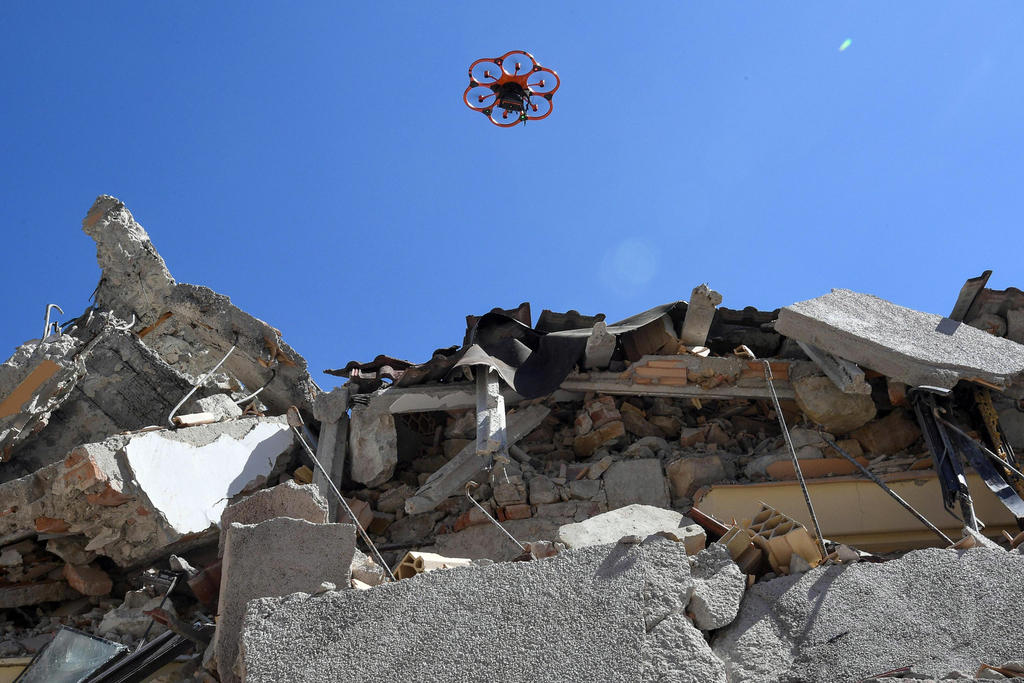
An ‘ideas salon’ for the 21st century

Jet suits, flying cars, intergalactic microchips, and plenty of canapés were just some of the highlights at the recent World.Minds conference on mobility in Zurich.
Richard Browning, a former marine officer, ultra-marathon runner, oil trader, and family man – and who is not yet 40 – has now invented a jet suit that can fly at speeds of up to 450 km/h.
Why? Why not! As a backdrop video montage streams through the various trials and tribulations – and ultimate success – of his real-life Iron Man suit, he tells the 400-odd crowd in Zurich’s Kaufleuten theatre that he simply “likes a challenge”.
Unfortunately, he hasn’t the permission to do a live demo in the venue. Neither was he allowed do so in the nearby Zurich main station. Apparently, 1,000-horsepower jet engines tend to “frighten commuters”, he says. But the audience is rapt as he runs through the sensations and callisthenic strength that are involved in teaching your body to fly. The suit may soon even be picked up by Red Bull for a racing circuit, he says.
Browning is the first of 15 speakers to appear on stage in 10-minute time slots throughout this World.Minds event on May 9, focused on the theme of ‘mobility’. And though the speakers range from entrepreneurs to business leaders and scientists, his self-confident pursuit of progress (the motto flashing below the logo of his Gravity Industries is “innovate into the unknown”) sets the tone for a futurism-soaked event.
He will be followed by, amongst others: a Stanford aeronautics expertExternal link who plans to shoot a one-inch satellite to the next galaxy using laser beams – a project which will take 25 years; a pair of ETH Zurich studentsExternal link who have designed a working model of a hyper-speed vehicle to ferry passengers in underground tunnels between European cities in a matter of hours; a researcherExternal link studying bird movements to design robots with working vision; a strategistExternal link from Switzerland’s Federal Railways; and a singer from Berlin who uses technology to sing a four-voice acapella harmony with herself.
Egged on by the enthusiasm of entrepreneur Rolf Dobelli, founder of World.Minds and MC for the day, most of the speakers are relaxed and optimistic. The future, after all, is bright. Or rather, it is when you focus more on the technologies themselves and less on their potential misuse.

More
How drones are transforming humanitarian aid
“I wanted them [the speakers] to give a wake-up call to the audience,” says Kipper Blakeley, World.Minds operations manager and curator of this event; but sometimes the exuberance of scientific researchers is hard to square with negative implications…
Building bridges
And yet this is exactly what the event exists to facilitate, says Blakeley: exchanges between sectors that would not usually speak with each other. The foundation, which is non-profit and funded by private donors, aims to “build bridges” between business and research. It says, “CEOs and scientists are often wrapped up in their individual silos”.
At the annual flagship version of the event each winter, philosophers and social thinkers also provide more context, including by highlighting possible negative consequences of progress.
The crowd – which mingles in this spirit of “sharing insight” during designated half-hour break-times – is also diverse: business leaders (the General Director of Yandex Europe, an internet search engine, tells me about opportunities in the Russian market), scientists (a plant-geneticist from the University of Zurich complains about the public’s distaste for GMOs), and the occasional outlier (Sabine Dobelli, wife of Rolf, is a novelist).
It’s an elite bunch that are all here by invitation only, and they swap business cards and share ideas. Many line up to test a flight simulator machine that was described, tongue-in-cheek, by Dobelli as “better than sex”. Many of them already seem to know each other. No ties are allowed. Breitling watches are gifted to each of the speakers; long lists of corporate sponsors are frequently thanked.
Dobelli, during one of his forays on stage, announces rather grandly that World.Minds is more than just a marketplace for science: it’s a “community”, he says, an intellectual gathering bringing together new ideas in the spirit of the “salons” of the 18th and 19th centuries. And though the numbers have swelled since the first edition brought together 30 people in a small Zurich bar a decade ago, the close-knit – albeit elitist – spirit remains.
This is also what differentiates it from the unavoidable comparisons with TED, that global juggernaut of idea-mongering.
“We collaborate closely,” says Blakeley. “But we are more about the community, the people that are here on the day [rather than the public focused videos of TED].” World.Minds is also much more focused on the science, while TED goes for the more traditional inspiration stories.
An ageing future
That’s not to say that the styles are not sometimes similar. Back in the Kaufleuten theatre, final speaker Joe Coughlin has clearly honed his presentation manner across years on the competitive conference circuit. He also appears on YouTube in a TEDx video from 2011.
In a statistic-littered presentation, the excitable director of MIT’s AgeLab leaps around the stage like some modern bow-tie wearing prophet, expounding on a topic that might at first glance seem tangential to the day but which ultimately he says is key for the future of mobility: the rapid ageing of societies, and not just in the West.
What does this aged future hold in store?
It is “grey”, Coughlin says, with more prevalent and more financially relevant over-60-year-olds. It is “delayed”: 30 will firmly become the new 20. It is “small”: we are no longer having children, while some 31% of households in Europe are currently made up of just a single person, a growing figure. And, finally, the future is “female”, he says – women will become both more educated and more ambitious than their male counterparts, and thus take more initiative in shaping societal movements.
Are these trends positive? Coughlin remains neutral. The audience, a healthy mix of male and female, seem engaged, but whether by the speaking style or content is unclear. One thing is clear, however, from Coughlin’s presentation: mobility on the human level – sheer getting off your backside to pursue projects and new goals, something he calls “motility” – will be key to navigating this new world.

In compliance with the JTI standards
More: SWI swissinfo.ch certified by the Journalism Trust Initiative





























You can find an overview of ongoing debates with our journalists here . Please join us!
If you want to start a conversation about a topic raised in this article or want to report factual errors, email us at english@swissinfo.ch.